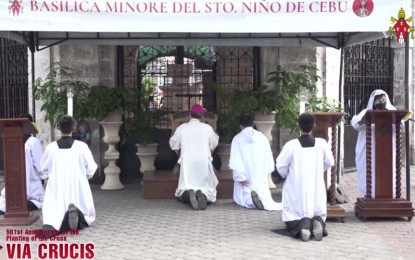
MAGELLAN'S CROSS. Bishop Midyphil Billones (center with violet skull cap) kneels with the Acolytes in front of the Magellan's Cross to commemorate through Via Crucis (Way of the Cross) its planting by Spanish explorers led by Ferdinand Magellan on April 14, 1521. The cross remains right on the same spot it was planted 501 years ago. (Photo courtesy of the Basilica Minore del Sto. Niño)
CEBU CITY – Cebuanos on Maundy Thursday marked the 501st anniversary of the planting of the cross by the Spaniards through the "Via Crucis" (Way of the Cross) at the Magellan’s Cross Pavilion right on the spot it was planted on April 14, 1521.
“How beautiful is this celebration. We are doing this in line with the historical celebration of April 14 where the planting of a cross was done in this vicinity” some 501 years ago, Cebu Auxiliary Bishop Midyphil Billones said in his sermon during the event.
Besides remembering the planting of the cross by the Spanish explorers, Billones reminded the Catholic faithful to reflect on the role of the cross in the Paschal Mystery – the passion, death, and resurrection of Jesus Christ.
While still reeling from the effect of the Covid-19 pandemic, Typhoon Odette, and the Typhoon Agaton, the bishop urged the faithful to contemplate on “so many crosses in life”.
“But with Christ on the cross there is suffering, but if we can stand with the power of resurrection,” he said, adding that through the cross, “we celebrate the paschal triduum… we die with Christ, we rise with Christ to new life”.
Ferdinand Magellan, a Portuguese explorer serving the Spanish crown, erected a wooden cross on the shores of Cebu, after persuading the chieftain, Rajah Humabon and his wife, Juana, to be baptized as Christians.
Humabon was the first indigenous king of the Philippines to be converted to Christianity, after he, his wives and the people of Cebu were baptized by a missionary priest. Then he was named Carlos in honor of King Carlos I of Spain, while his wife Hara Amihan was named Juana, after the king's mother.
The cross that signifies the establishment of Christianity in the Philippines has been housed in a small chapel or kiosk shaped like a gazebo. It is situated right on the same spot it was planted in Plaza Sugbo, near the entrance to the Basilica Minore del Sto. Niño.
The kiosk, the church building itself and a convent, were collectively declared “national cultural treasure” by the National Museum of the Philippines on April 14, 2021.
In 1941, a plaque was placed just above the entrance of the kiosk that says: "From time immemorial this spot has been set aside to commemorate the erection of a cross in Cebu by the Expedition of Magellan".
Apart from being a symbol of Cebu City’s heritage, the Magellan's Cross is a popular tourist attraction in Cebu. (PNA)
